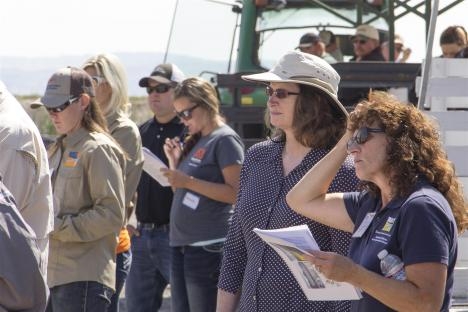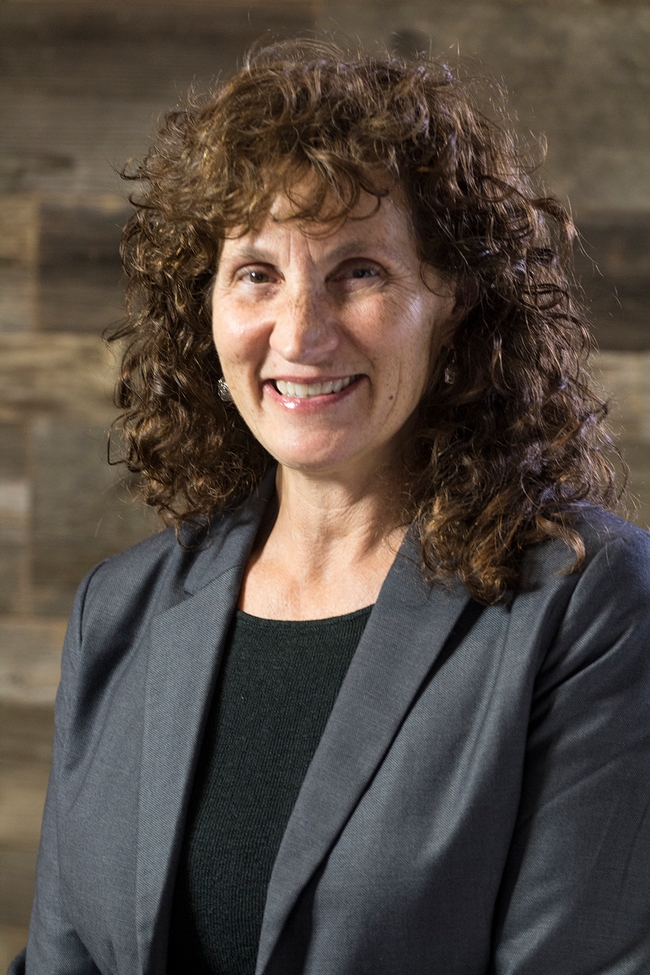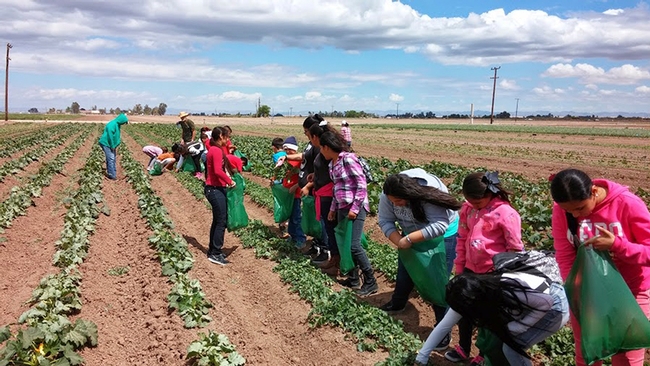REC System director Lisa Fischer reflects on strengths and potential of the research and extension centers as she retires
After a nearly 30-year career that took her from the U.S. Forest Service to director of UC ANR's Research and Extension Center system, Lisa Fischer is retiring. Her last day is Sept. 30. Darren Haver will serve as interim associate director through the end of the fiscal year.
Fischer joined ANR five years ago as the associate director of the Research and Extension Center system, after more than two decades with the U.S. Forest Service. She was later promoted to director of the RECs.
UC's ANR's nine Research and Extension Centers (RECs) connect UC research and education activities to regional challenges and issues. The nine centers extend from the Oregon border south to Imperial County. Each center has a unique focus. They provide land, labor, facilities and equipment that serve as an outdoor laboratory for researchers focusing on agriculture and natural resources. The RECs also serve as focal points for community participation and education, serving as hubs for UC ANR programs such as Master Gardeners, Master Food Preservers and 4-H. UC ANR RECs also partner with non-UC researchers, including scientists from U.S. Department of Agriculture and California State University. This is publicly funded research at its best.
We recently sat down to talk about her career.
What did you do prior to joining UC ANR? How did that work equip you for your career here?
Prior to joining ANR, I spent 21 years with the U.S. Forest Service. I managed and oversaw statewide and regional programs focusing primarily on forest health for California, Hawai'i and the Pacific Islands. Other statewide programs I was responsible for included conservation, education and forest stewardship. In many ways, the work was similar to the kind of work we do at ANR: working with state and private interests and other cooperators to deliver a full suite of programs to clientele.
I had a very long relationship with UCCE before joining the organization. My relationship with ANR dates back to the mid-1990s, when I was involved in a collaborative project with the Integrated Hardwood Range Management Program.
You received your degrees in Geography from UC Santa Barbara. How has that discipline helped you in your ANR career?
Fischer: Geography is about observing patterns in nature. When I think about that and my journey for the last five years, that disciplinary training seems incredibly applicable. Literally my first goal as Associate Director was to observe: to visit each REC, see what was happening, what each did and what each had to offer. It related not only in terms of learning the unique aspects of each REC, but how each fit into what I can only term a massive, grand and complex system.
For the first nine months, I was simply taking in a great deal of information. The time observing the RECs and speaking with a wide range of people (both within and outside of ANR) enabled me to identify some areas that we really wanted to try expand upon.
A key goal coming in was to increase the visibility of the REC system…to create more of a REC brand. There was another piece to that, which was considering how we might begin to engage in different activities, and considering what that would require.
The process of getting out and exploring possibilities with the REC directors was immensely fun, engaging and productive. We visited campus departments and spoke with graduate students, including those enrolled in geography, ecology and plant sciences.
UC ANR has done a wonderful job of providing hands-on experiences for K-12 and for UC and CSU students. It was also important for me to provide experiences for community college students. One of things I did early on with Bill Frost's blessing was to create an intern program. Initially, we were looking at how students might help us help to gain visibility, but we realized that these experiences might lead to future employment opportunities for these young people. So, I wove that into the pattern I saw.
I have always tried to be creative and consider how we can grow our REC system both internally as well as externally.
The RECs are being used in some new and exciting ways. Could you elaborate on that?
I'm very passionate about the Extension part of our work. Internally, I began having conversations in hallways about bringing groups together that could actually be present at the RECs. A central question was “How can we use these inter-connected physical places and locations across the state to benefit and host the full suite of ANR programs?”
One of the first centers to do this was South Coast REC in Irvine, where Director Darren Haver brought Cooperative Extension county programs and REC programs under one umbrella. Slowly, we also did that this at Hansen Agricultural Research and Extension ECenter (HAREC) in Ventura County. And for the first time ever, every acre at HAREC is being used for research and educational activities. More academics are engaging with RECs. We've improved.
Another creative and interesting opportunity has arisen from taking amazing research and programmatic work, and packaging it and delivering it in various ways to different audiences, from K-12 to the general public to international groups. Having RECs focusing on outreach, integrating programs and bringing different ideas for new outreach efforts has been very successful on a number of fronts. For example, Project Learning Tree uses RECs as places to convene different clientele and stakeholders. They conduct not only forestry-related teacher training, but also training to equip those educating others about natural resources, agriculture, wastewater and more.
We've really expanded the community educator capacity in the REC system. A model for the great potential of this work has been the Farm Smart program at Desert REC (DREC) in Imperial County. Farm Smart provides an on-site educational program serving grades K-12 and winter visitors (“snowbirds”). To date, it's served over 120,000 people. It's a very successful outreach and extension program that integrates a REC-based program with a county-based program. We've used Farm Smart as a model to launch other programs and educator positions across the system, including Sustainable You, a youth-development program that's involved 4-H, Master Gardener volunteers, the California Naturalist Program, Project Learning Tree and other county-based community educators. Sustainable You – a program developed by Utah State University – has launched at several RECs.
Which accomplishments are you most proud of?
I think that the strategic planning effort we undertook was absolutely amazing. When I came to ANR five years ago, one of the tasks given to me was to lead the creation of fully stakeholder-driven strategic plans. The process we developed to create these plans was amazing. Each of the nine centers convened committees consisting of stakeholders, specialists and advisors within thematic areas that were unique and critical to each REC.
It was a creative and open process that allowed for a continual flow of information from many and diverse parties.
It has been inspiring to develop and look out at a long-term plan (each plan projects out 20 years). What will the center look like? What will the work look like? What will the research facilities look like? How will we get there? The unique part of these plans is that they key in on a broad, strategic lens that reflects public values, such as enhanced science literacy. Goals are considered through these lenses, which has resulted in very strategic and creative action plans. These plans include anticipated outcomes and expected deliverables, but provide flexibility to adapt as the need arises. These are living plans that REC directors and their successors can reference, utilize, refine and use to guide annual work.
The strategic planning process also broadened our thinking and created an entire new set of questions about who we might work with at each REC, and the diversity of research efforts that might be undertaken in the future. Could we work with engineers? Artists? Writers? How do we expand partnerships in ways that not only help us maintain fiscal health and stability, but in ways which will enhance the diversity of research and education activities? Because of the sprawling nature of the REC system and the physical space that divides us, we've even discussed distance learning.
After five years, what's your takeaway about the REC system you've managed?
My perspective on the REC system is that it represents a simply amazing breadth of ecosystems and much of the amazing geographic and physical diversity that characterizes California. It's a unique place-based system that incorporates research, education, outreach and extension.
I feel as if I've just touched on the surface of what's possible here.
What would you want to tell advisors and others beginning their career with UC ANR?
Until I got involved in this position, I had no true understanding of how extraordinarily valuable a resource the RECs are for researchers and California taxpayers. These diverse physical locations exist as creative spaces for research and programmatic development and delivery. Opportunities abound. The potential is unlimited.
I'd also tell people to keep their eyes open and to consider the other kinds of research and programmatic opportunities that might arise. Step outside of the box a bit. It's essential to keep the research and extension mission in focus. But knowing that is our focus, it's important to note that research is very expansive: there are social, physical, biological, chemical, mechanical, and cultural aspects of critical issues that can be explored. Research can be conducted in any number of disciplines at the RECs. So, continue to seek out those different opportunities…that will assure that ANR remains in the forefront of creative research and Extension work.
I feel very strongly about that.



